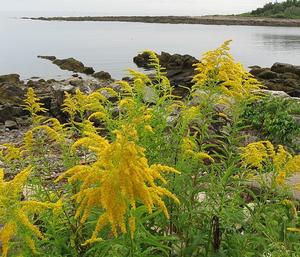Printed at http://www.newmoonnursery.com/index.cfm/
Solidago nemoralis
Prairie goldenrod
Native to North America
FIRST IMPRESSIONS: Solidago nemoralis is an upright unbranched perennial wildflower that is peppered with short grayish hairs. Leaves are alternate and narrowly lanceolate. In autumn for about a month, stems are terminated with narrow wand-like panicles of yellow flowers. Plants are tough and adaptable, prospering in sunny dry or mesic sites.
HABITAT & HARDINESS: Solidago nemoralis occurs through the southern Canadian provinces and in the United States west to Montana, Wyoming, Colorado and New Mexico. In a few western state, this goldenrod is considered to be a troublesome weed.
Indigenous plants occur in mesic to dry Blackland prairies, gravel prairies, sand prairies, sandy oak savannas, glades, loess hills, dry open woods and bluffs, sand dunes, fence rows, eroded clay banks, fallow fields and roadside or railroad right-of-ways. Plants occur in both disturbed and high quality habitats.
Plants are hardy from USDA Zones 3-9.
PLANT DESCRIPTION: Solidago nemoralis is a low growing unbranched perennial with pubescent green or reddish stems. This species can form clonal colonies from its fibrous root system, thick branching caudex and network of rhizomes.
The leaves are alternate, pubescent and up to 4” long and 3/4” wide. Blades are grayish-green and narrowly lanceolate or elliptical with narrow tapered petioles. The leaf margins are smooth or slightly toothed.
As the stems rise, the leaves become smaller. They often have tiny clusters of secondary leaves nestled in the axils on the upper stems.
The central stem is topped by a narrow nodding panicle. The entire inflorescence is 3-8” long containing many ¼” flowerheads. Each head has 4-10 ray florets surrounding a similar number of disc florets.
The florets mature into small achenes crowned by tufts of hair. Plants proliferate when the achenes are distributed by wind and offsets form from the underground rhizomes.
Plants grow 6-30” tall with an equal spread.
CULTURAL & MAINTENANCE NEEDS: Solidago nemoralis thrives in sunny sites with slightly acidic mesic to dry soil. Plants tolerate part sun, drought, alkaline pH and rocky sandy, loamy, clay or gravelly soils.
This species is relatively pest free. Plants often spread aggressively in ideal moist sunny sites.
LANDSCAPE USES: This is a good choice for a Wildlife Garden or Meadow. Plants are also used as Butterfly Nectar Plants or as part of a Grouping or Mass Planting. Solidago nemoralis has Showy Blooms and can be used in Cottage Gardens, Water-wise Landscapes, Low Maintenance Plantings, Perennial Borders, Rock Gardens, Roadsides and Restoration Projects.
COMPANION & UNDERSTUDY PLANTS: Try pairing Solidago nemoralis with Aster oblongifoius, Carex pensylvanica, Liatris aspera, Monarda punctata, Sorghastrum nutans or Schizachyrium scoparium.
If a substitute is needed, Solidago speciosa is a goldenrod that thrives in similar cultural situations.
TRIVIA: Native bees, wasps, butterflies, moths, beetles and pollinating flies seek nectar and pollen from the flowers. Plants host the caterpillars of several moth species. Seed are eaten by songbirds like Eastern Goldfinch. White-tailed Deer and Cottontail Rabbits graze on the foliage.
Solidago nemoralis is commonly called old field goldenrod or field goldenrod because this hardy pioneer species populates harsh dry sites like abandoned fields.
Solidago nemoralis can be distinguished from other Solidago spp. by its later blooming time, lower height, narrow wand-like panicles, presence of short fine hairs on stems and leaves and secondary leaflets along the upper stems.
Height:
6-30 inSpread:
6-30 inSpacing:
12-30 inUSDA Hardiness Zone:
3-9Bloom Color:
YellowSolidago nemoralis Characteristics
Attracts Wildlife
- Pollinators
- Butterflies
Attributes
- Dried Flower
- Cut Flower
- Rock Garden
- Clay Soil
- Naturalizing
- Long Blooming
- East-Coast Native
- Drought Tolerant
Exposure
- Full Sun
Deer Resistant
- Deer Resistant
Flowering Months
- September
- August
- November
- October
Foliage Color
- Green
Growth Rate
- Medium
Juglans nigra Tolerance (Black Walnut)
- Yes
Soil Moisture Preference
- Dry
Interesting Notes:
For more information on this plant, visit the USDA PLANTS Database: http://plants.usda.gov/java/profile?symbol=SONE

